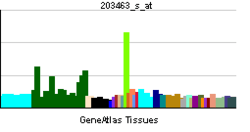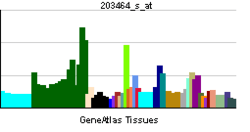EPN2
Epsin-2 is a protein that in humans is encoded by the EPN2 gene.[3][4]
This gene encodes a protein which interacts with clathrin and adaptor-related protein complex 2, alpha 1 subunit. The protein is found in a brain-derived clathrin-coated vesicle fraction and localizes to the peri-Golgi region and the cell periphery. The protein is thought to be involved in clathrin-mediated endocytosis. Alternate splicing of this gene results in two transcript variants encoding different isoforms.[4]
References
Further reading
- Salcini AE, Confalonieri S, Doria M, et al. (1997). "Binding specificity and in vivo targets of the EH domain, a novel protein–protein interaction module". Genes Dev. 11 (17): 2239–49. doi:10.1101/gad.11.17.2239. PMC 275390
 . PMID 9303539.
. PMID 9303539.
- Yamabhai M, Hoffman NG, Hardison NL, et al. (1998). "Intersectin, a novel adaptor protein with two Eps15 homology and five Src homology 3 domains". J. Biol. Chem. 273 (47): 31401–7. doi:10.1074/jbc.273.47.31401. PMID 9813051.
- Kikuno R, Nagase T, Ishikawa K, et al. (1999). "Prediction of the coding sequences of unidentified human genes. XIV. The complete sequences of 100 new cDNA clones from brain which code for large proteins in vitro". DNA Res. 6 (3): 197–205. doi:10.1093/dnares/6.3.197. PMID 10470851.
- Ford MG, Mills IG, Peter BJ, et al. (2002). "Curvature of clathrin-coated pits driven by epsin". Nature. 419 (6905): 361–6. doi:10.1038/nature01020. PMID 12353027.
- Strausberg RL, Feingold EA, Grouse LH, et al. (2003). "Generation and initial analysis of more than 15,000 full-length human and mouse cDNA sequences". Proc. Natl. Acad. Sci. U.S.A. 99 (26): 16899–903. doi:10.1073/pnas.242603899. PMC 139241
 . PMID 12477932.
. PMID 12477932.
- Hussain NK, Yamabhai M, Bhakar AL, et al. (2003). "A role for epsin N-terminal homology/AP180 N-terminal homology (ENTH/ANTH) domains in tubulin binding". J. Biol. Chem. 278 (31): 28823–30. doi:10.1074/jbc.M300995200. PMID 12750376.
- Ota T, Suzuki Y, Nishikawa T, et al. (2004). "Complete sequencing and characterization of 21,243 full-length human cDNAs". Nat. Genet. 36 (1): 40–5. doi:10.1038/ng1285. PMID 14702039.
- Colland F, Jacq X, Trouplin V, et al. (2004). "Functional Proteomics Mapping of a Human Signaling Pathway". Genome Res. 14 (7): 1324–32. doi:10.1101/gr.2334104. PMC 442148
 . PMID 15231748.
. PMID 15231748.
- Jin J, Smith FD, Stark C, et al. (2004). "Proteomic, functional, and domain-based analysis of in vivo 14-3-3 binding proteins involved in cytoskeletal regulation and cellular organization". Curr. Biol. 14 (16): 1436–50. doi:10.1016/j.cub.2004.07.051. PMID 15324660.
- Ballif BA, Villén J, Beausoleil SA, et al. (2005). "Phosphoproteomic analysis of the developing mouse brain". Mol. Cell Proteomics. 3 (11): 1093–101. doi:10.1074/mcp.M400085-MCP200. PMID 15345747.
- Kimura K, Wakamatsu A, Suzuki Y, et al. (2006). "Diversification of transcriptional modulation: Large-scale identification and characterization of putative alternative promoters of human genes". Genome Res. 16 (1): 55–65. doi:10.1101/gr.4039406. PMC 1356129
 . PMID 16344560.
. PMID 16344560.
- Olsen JV, Blagoev B, Gnad F, et al. (2006). "Global, in vivo, and site-specific phosphorylation dynamics in signaling networks". Cell. 127 (3): 635–48. doi:10.1016/j.cell.2006.09.026. PMID 17081983.


 . PMID 9303539.
. PMID 9303539. . PMID 12477932.
. PMID 12477932. . PMID 15231748.
. PMID 15231748. . PMID 16344560.
. PMID 16344560.